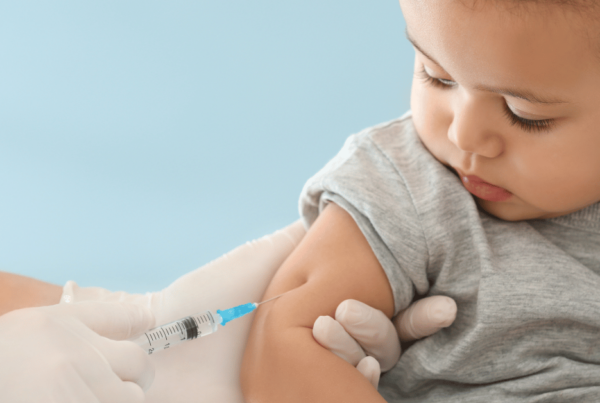This summer a case of paralytic polio was reported to the CDC. I’ve been getting a number of questions from my community, so I’ve written a three-part series of articles explaining what parents need to know about polio. This article is about how the oral polio vaccine causes polio outbreaks.
- What Is Polio? How is it Prevented & Treated?
- How Do Polio Vaccines Cause Polio?
- Inactivated Polio Vaccine: What Parents Need To Know
The strain of polio detected in New York was derived from a vaccine. This has left many parents wondering: What is vaccine-derived poliovirus and how do vaccines cause polio?
Live Vaccines VS. Inactivated Vaccines
Live vaccines contain live viruses which have been weakened (aka attenuated). This is the case with the oral polio vaccine. Live vaccines tend to be more effective, but they come with the downfall of virus shedding and more serious side effects.
Virus shedding is where live virus particles are shed in stools after vaccination. Virus shedding occurs for up to 14 days in healthy people and may occur much longer in immunocompromised people. These virus particles can then infect immunocompromised people or people who haven’t been vaccinated.
Inactivated vaccines contain pieces of the virus rather than the whole virus. They don’t shed live viruses in stools and can’t cause infectious diseases. This is the case with the injected polio vaccine, which is the vaccine given in the majority of high-income countries in the world, including the United States.
How Do Weakened Vaccine Derived Viruses Become Infectious?
Weakened vaccine-derived poliovirus from vaccines can cause infections in susceptible people. Because of the virus’ weakened state, it generally won’t cause any outbreaks or significant illnesses that involve the nervous system.
However, if the weakened vaccine-derived poliovirus is allowed to spread through a population of susceptible people, it can mutate or revert to a form of the original, extremely infectious virus.
When the virus becomes strong enough to circulate widely in a community, the name changes from vaccine-derived poliovirus (VDPV) to circulating vaccine-derived poliovirus (cVDPV).
Attaining neurovirulence is the process by which the vaccine-derived poliovirus becomes able to infect the nervous system and cause symptoms like paralysis and encephalitis.
Why Is The Live Polio Vaccine Still Used?
Currently, there are more global cases and outbreaks involving vaccine-derived polio than wild-poliovirus. This leads to the question: why are live polio vaccines still being used?
The first reason is that while both live polio vaccines and inactivated polio vaccines are very effective at protecting people from polio, live polio vaccines are more effective at stopping transmission. Therefore, in places with polio outbreaks and low vaccine coverage, a live polio vaccine is needed to stem the spread of polio.
A second reason that the live polio vaccine is used in some areas is that it is cheaper to produce and easier to administer than the injected polio vaccine. This makes the live polio vaccine the best option in areas with less developed health infrastructure and funding.
To completely eradicate polio from the world, we will eventually have to switch from live polio vaccines to inactivated polio vaccines or create more stable live polio vaccines that won’t mutate to become infectious.
Will The Inactivated Polio Vaccine Protect My Child Against Vaccine-Derived Strains?
After learning that the live polio vaccine is more effective in some ways than the inactivated polio vaccine, some parents wonder whether they should give their kids the live polio vaccine instead. My opinion is that when the inactivated vaccine is available, that is the preferred vaccine because of it’s safety profile. Note: Only the inactivated polio vaccine is currently available in the United States.
Both the live and inactivated polio vaccines provide excellent protection against polio disease. The injected polio vaccine protects people against infection from all wild-type and vaccine-derived poliovirus strains, including the strain that caused the case of paralytic polio in New York in 2022. New York has initiated a campaign to increase coverage of the injected polio vaccine.
The injected polio vaccine produces 90% immunity after 2 doses and 99% immunity after 3 doses. The duration of immunity is uncertain. The benefits of the injected polio vaccines are that they cause less serious side effects and don’t shed viruses which put others in the community at risk.
Summary
Live polio vaccines can, in rare cases, cause polio. Live vaccines are made with weakened virus particles, which can be shed in the stools of recently vaccinated people and cause disease in susceptible individuals. If the weakened vaccine-derived poliovirus is allowed to spread, it forms mutations that make it more infectious and likely to cause serious disease.
Live polio vaccines are still used because they are better at stopping transmission, less expensive, and logistically simpler than inactivated vaccines. To eradicate polio globally, we will have to exclusively use inactivated polio vaccines or develop stable live vaccines.
In countries like the United States, with good health infrastructure and no circulating polio, the inactivated polio vaccine is used. The inactivated polio vaccine cannot cause polio and provides excellent protection.
Next: Inactivated Polio Vaccine: What Parents Need To Know – Dr. Green Mom
Further Reading:
Vaccine-Derived Poliovirus | CDC
References:
Hird, T. R., & Grassly, N. C. (2012). Systematic review of mucosal immunity induced by oral and inactivated poliovirus vaccines against virus shedding following oral poliovirus challenge. PLoS pathogens, 8(4), e1002599. https://doi.org/10.1371/journal.ppat.1002599
Wahid, R., Mercer, L., Macadam, A., Carlyle, S., Stephens, L., Martin, J., Chumakov, K., Laassri, M., Petrovskaya, S., Smits, S. L., Stittelaar, K. J., Gast, C., Weldon, W. C., Konopka-Anstadt, J. L., Steven Oberste, M., Van Damme, P., De Coster, I., Rüttimann, R., Bandyopadhyay, A., & Konz, J. (2021). Assessment of genetic changes and neurovirulence of shed Sabin and novel type 2 oral polio vaccine viruses. NPJ vaccines, 6(1), 94. https://doi.org/10.1038/s41541-021-00355-y
Nzolo D, Ntetani Aloni M, Mpiempie Ngamasata T, Mvete Luemba B, Bazundama Marfeza S, Bothale Ekila M, Ndosimao Nsibu C, Lutete Tona N. Adverse events following immunization with oral poliovirus in Kinshasa, Democratic Republic of Congo: preliminary results. Pathog Glob Health. 2013 Oct;107(7):381-4. doi: 10.1179/2047773213Y.0000000113. PMID: 24392682; PMCID: PMC4083159.
Spate of polio outbreaks worldwide puts scientists on alert
2022 Health Alert #20: Update on Poliovirus in New York City


